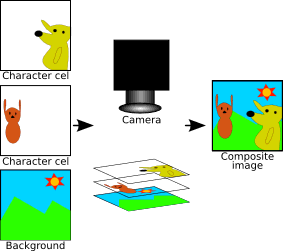Cel Animation
What is Cel Animation? Cel animation, which is more commonly known as Traditional Animation is a type of animation technique where each frame is drawn by hand, The technique was the dominant form of animation in the cinema until the advent of computer animation.
The processes of Cel animation include:
- Storyboards
- Voice recording
- Animatic
- Design and timing
- layout
- animation
- Digital ink and paint.
- pencil tests
- Traditional Ink-and-paint and camera.
Typically, Traditionally-animated productions just like any other forms of animation start of with a story board which is a script written in not a lot of detail and an image above, similar to a comic strip. The pictures remind the animation team how to plan things and what is next in the sequence to try and stick to a certain plan so that everyone knows what the story or animation is going to be about. It’s a rough starting point for all animations.
Next in the planning for an animation you have voice recording, before any final plans for animation begin the soundtrack or ‘scratch track’ is recorded, this makes it much easier so that the animators can sync up the soundtrack to the animation precisely. It is easier for the animators to have a pre-existing soundtrack. The completed cartoon or animation will be complete with music, sound effects and a dialogue performed by voice actors.
Pre-1930 sound animated cartoons were post-synced, this means that the sound track was recorded after the film was entirely animated and ready, and playing the sound effects and dialogue when needed, most commonly by a studio called Fleischer continued to post-sync their cartoons through most of 1930.
Usually the animatic story reel is made after the soundtrack is created, but before the full animation begins, an animatic is usually created and consists of pictures from the storyboard synchronized with the soundtrack. This lets the directors and animators work out any script issues and timing problems that may appear with the storyboard at it’s current state, this allows them to be able to apply changes before anything final has been done. If necessary they can create a whole new animatic and await review until the story board is up to their standard. The animation process is a long and expensive process so they need to make sure that the storyboard is perfected until they spend money and time on creating it.
Advertising companys usually employ the use of animatics to test run their adverts before they are made into full spots. Animatics are drawn art work with moving pieces, they usually are 2D and 3D with some sketches in, depending on whether they are live action or not depends on the amount of detailing that goes into it.
The cel is an important innovation to traditional animation as it lets some bits of each frame to be repeated from frame to frame which saves a lot of time.
In early cartoons before the usage of cel, such as Gertie the Dinosaur (1914), the entire frame including the background, characters and items were drawn on one sheet of paper, then photographed and Everything else had to be re-drawn for each frame after that had movements in them, It made the animation appear sharp and jittery but in some cases this was a particular art style. A frame was made by removing all of the blank parts and the objects were drawn before being placed on top of the backgrounds and finally photographed. The Cel animation process was invented by Earl Hurd and John Bray in 1915.
Cel overlay is a cel with inanimate objects that are used in animation to give the impression that there is a foreground on top of an already placed frame, this effectively creates the illusion of depth, but doesn’t create as much depth that a camera would produce. A special version of cel overlay is called line overlay and this is made to complete the background instead of the foreground and it was created to fix the sketchy appearance of xeroxed drawings. The background would be painted at first and shapes and flat colours would appear, it would have very little design detailing in it and then this is where you would add a cel with very detailed black lines and it was placed directly over the background layer. It gave shape to the background and gave it the complexity it needed, This visual style background will match the xeroxed character cels as the process overlay was left behind.





